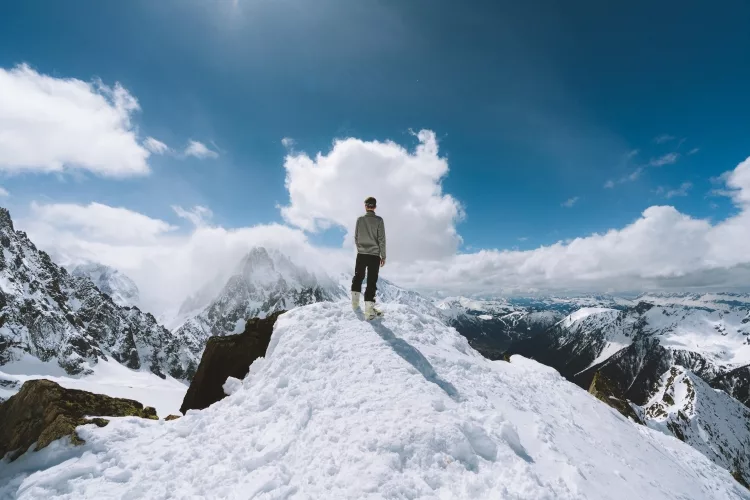How To Prepare For High Altitude Skiing
by Frank V. Persall
If you are reading this, it's highly probable that you're contemplating high-altitude skiing. Keeping yourself in good shape at altitude can be the key to getting the best out of your vacation. So, if you are looking for how to prepare for high altitude skiing, we've got you covered.
Contents
Every year, people make out the time to go on ski vacations. The picture that they have of these vacations is usually perfect but one thing that they seem to neglect is the altitude. If you have not acclimated to high elevations, you need to be wary of any ski resorts that exceed 8,000 ft. Some people may not feel the effects of high elevations depending on where they reside but we cannot say the same for everyone. This is especially true if you live at sea level.

The reason is that there is a 25% reduction in how much oxygen you can access at 8,000 feet. Since you will be breathing air with less oxygen, you have a high risk of suffering problems like headaches, shortness of breath, fatigue, and nausea, as well as dizziness, and loss of appetite. In worse cases, high altitude skiing could lead to altitude sickness.
How Long Does It Take To Adjust To High Altitude
Acclimatization is the key to adjusting to high altitudes. But you might require a couple of days or weeks for your body to adapt to higher elevations. People who are not used to high altitudes will likely experience something that feels like a hangover. This is what is known as altitude sickness.
Can You Get Altitude Sickness From Skiing?
Lots of visitors who are used to lower elevations might end up experiencing altitude sickness. These cases are self-limited most of the time and will resolve after acclimatization. If you suffer altitude illness, you are likely to experience fatigue, nausea, shortness of breath, as well as sleep disturbances and headache. After 24 hours, these symptoms usually worsen but start to diminish after 4-5 days. One of the most effective ways of remedying altitude sickness in its mild form is adequate rest. But other ways of treating the condition are as follows -
- Keep yourself hydrated. The process of acclimatization usually comes with the loss of fluid which is why you should drink more fluids to help your body stay hydrated.
- Since respiration diminishes while asleep, it can act to worsen the symptoms of your condition. So, engage in light activity during the daytime.
● Steer clear of alcohol and tobacco, as well as any form of depressant drugs.
- Wait until you become fully acclimatized before engaging in vigorous exercise. Avoid any
activities that need you to use up lots of energy. Rather than use medications, limiting exertion can help.
How Do You Prepare For High Altitude?
Dealing with high altitude can be achieved through acclimatization but this is more a long-term approach. If you can dedicate the time to get set for your trip, you'll be better off eventually. There are some pieces of training that you can take up before your trip. These training areas may last anywhere from 6 weeks to 12 weeks but they will help you prepare your body and mind for high altitude skiing. Here they are:
Breath Control
Breathing is an activity that takes place automatically in the body which means it doesn't have to be contemplated before it occurs. This is a good thing because the average grown-up breathes anywhere from 17,000 to 30,000 times daily. But the downside is that it makes people unaware of how powerful they can be in being able to control their breathing. To help you prepare for high altitude skiing, you can try the Breathe-Hold-Breathe technique. This technique is very easy and it's something you should do on a daily basis because it is very effective. You can begin by doing the 12-second breath intervals and gradually start to work your way up. Here's how to do it -
- Breathe in for four seconds through your nostrils.
- Hold your breath for about four seconds
- Breathe out for four seconds through your mouth.
Aerobic And Anaerobic Training
Aerobic training comes in different forms and distance running is a typical example. This is about pushing your body with intensity at a low, consistent rate. But in the case of anaerobic training, a good example is the hundred-meter sprint where you have to work at the highest possible intensity or exert your body at very high levels within short bursts of time.
Sports such as skiing do not always involve a single state of exertion. Rather, what is involved is a consistent switching between aerobic and anaerobic states. This is why you need to engage in regular adapted training in aerobics and anaerobic exercises. These will help to increase your chances of performing even better on the slopes.
In the case of anaerobic exercises, what you are mostly concerned about is putting in your highest effort. But it is best to do this little by little and on a more regular basis. This should be done in a single session and not essentially as an everyday activity. You have a substantial reason not to consider doing this daily because the simple truth is that you can't. Training sessions like this are not to be taken lightly which is why you need to take a break between sessions to allow the recovery process to kick in. During your rest time, you can also get adequate sleep and help your muscles repair.
You can use the Sprint-Recover method to carry out your sprint training on a football field. All you have to do is sprint the entire length of the field and help your body recover by walking the width. Your objective should be to do the highest possible number of laps that you can with consistency in just one session. This should be done once or twice per week.
Key Suggestions On How To Prepare For High Altitude Skiing
Here, we've put together 6 helpful suggestions that will ensure you stay healthy at a higher altitude. It will also help to make your vacation a memorable one not just for you but for your loved ones as well.
Use Proper Clothing
Your choice of dressing should be one that protects you from cooler temperatures but we also
advise that you stay prepared in case the weather changes suddenly. Higher altitudes are usually cooler and it's a great idea to have layers of clothing. Depending on the weather condition at the time, it may feel warmer or cooler. That's why dressing in layers is advised while ensuring that your clothes are breathable.
Stay Hydrated
At higher altitudes, you will notice that the air is usually very dry and this will tell on your body.Increase your fluid intake and drink double the amount of water you normally will ingest. This
will help you thrive at a high-altitude.
No Tobacco, Caffeine, Or Alcohol
Whatever you do, steer clear of these substances initially or totally where possible. The effectsof alcohol usually become intensified as the altitude gets higher. Alcohol can also make your
dehydration worse which is the same thing that caffeine does as well.
Get Adequate Rest
To help you become acclimatized to high altitudes, getting a lot of rest is vital. this will also helpto keep you from getting exhausted quickly. You need to ease your body into the process until
you become fully adapted to higher elevation skiing. Do not exert yourself excessively within the
first two days.
Watch Your Diet
Vacation is usually a time where people indulge in very heavy meals once it is dinner time. Buteating the kind of diet that is right for your body can help your performance at high altitudes.
Potassium-rich foods like banana can help you in the acclimatization process. You can also keep
your blood sugar stabilizer with the help of complex carbohydrates. This will also optimize your
energy levels all through the day. Avoid salty processed foods and it will be best to stay away
from salt itself as these could lead to dehydration.
Use sunscreen
Never forget to make use of a high SPF sunscreen which needs to be reapplied regularly.Unfortunately, sunburns that occur at high altitudes are usually painful and could put you in
danger. Since there is less water available at such times, you will be directly exposed to the sun.
Sunburns can also be intensified because of the snow reflection.
Protect your eyes
Some people love to goggles while others are comfortable with glasses. No matter what yourchoice of protective gear for your eyes is, make use of a lens that is of superior quality. You do
not want to get your husband as the experience can be awful.
Conclusion
This brief guide has shown you what you need to know about how to prepare for high altitude skiing. Remember to keep yourself hydrated and eat the right foods. With these in mind, you are fully ready to enjoy the kind of thrill that the altitude brings.
Related Posts:
Best Way To Plan For A Ski Trip
 |
 |
 |
 |

About Frank V. Persall
Frank is originally from the UK, but he has a passion for skiing that knows no bounds. He has made it his life's mission to visit the best ski resorts across the USA and the World. Frank loves spending time with his wife and three children on ski slopes, as they all share his love for the activity.
Thoughts on "How To Prepare For High Altitude Skiing"
 |
 |
 |
 |
You can get FREE Gifts. Or latest free skiing books here.
Disable Ad block to reveal all the info. Once done, hit a button below
 |
 |
 |
 |